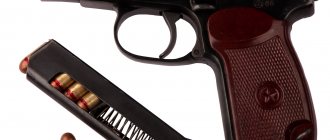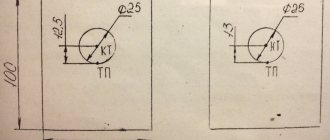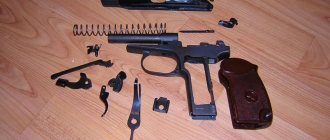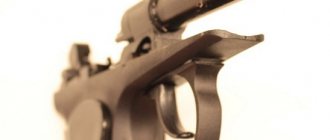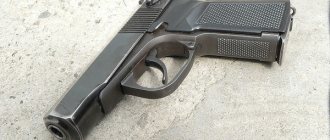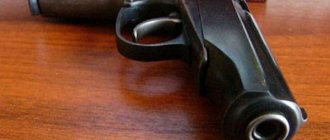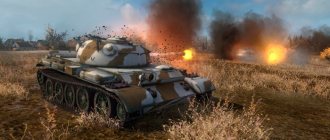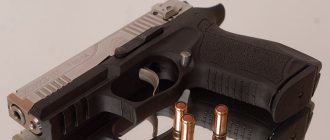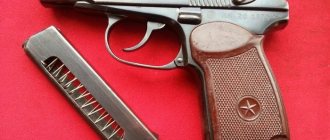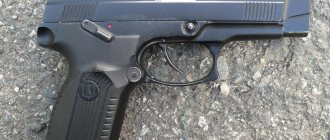The modernized Makarov pistol (better known as PMm, also known as the “Grach-3” project), as the name suggests, is the heir to the most popular pistol in the world - simply PM, which has been produced since 1951. The modernized version was put into service in 1994, and it is not very different from its ancestor - the pistol parts are 70% interchangeable. The incredible simplicity of the design, high reliability and extremely low cost made the PMM a worthy candidate to replace its eminent ancestor, but administrative decisions during its production and commissioning made this process unprofitable, leaving the PMM as the weapon of some law enforcement agencies and special forces.
History of the creation of the PMM pistol (PMM)
For the first time, the idea of reworking the classic PM of the 1951 model appeared as part of the R&D "Grach" - a complex of research and development work to develop new service weapons for employees of the special services, FSO, private security and other organizations that were no longer satisfied with the classic PM due to its obsolescence and design imperfections.
In total, several options were developed and tested within the framework of the “Rook” project, but “Rook-3” was recognized as the winner, which later received its official designation – PMM.
Standard equipment
When buying a new air pistol IZH 53M, you will find a rather meager set of equipment in the box. The manufacturer supplies with the weapon only a screwdriver, a cleaning rod (for oil), a trigger spring and a passport with technical data.
But it should be noted that modernization of the IZH 53M is possible. In particular, you can replace the spring (with a more powerful one), as well as the sight, since a dovetail mount is used (in models released in 2011 and later, this feature was excluded. Now only the standard sight can be used).
Upgraded Makarov pistol
Since 1994, when the first pistol of the new model rolled off the assembly line, the main line of PMMs has not undergone significant changes, but several more variations of PMMs have sprung off from the main model for various conditions and situations:
- PMM-8 – a classic solution from 1994. It is compact and can be carried semi-concealed (under a jacket or raincoat), but the small volume of the magazine does not allow use in open combat. A common solution for FSO and FSB agents in plain clothes, as well as for bailiffs. At the end of the 90s, it was supplanted first by its modification PMM-12, and then by more modern concealed carry pistols.
PMM-8 - PMM-12 is a new edition that has received an enlarged magazine and a noticeably thicker handle due to the denser placement of cartridges. Concealed carrying of the PMM-12 is almost impossible, but the additional four rounds in the clip give you a much better chance of survival in open combat. Mainly used by private security services, as well as other organizations in cases where the concealment of weapons is not necessary. At the moment it is the only mass-produced combat model. The cartridge is the same.
- IZH-70-100 – also known as IZH-70-17A, a sports model with a magazine for 12 rounds. It differs from the classic PMM-12 by a modernized adjustable sight. The cartridge is still 9x18 mm.
- Baikal 442 – an export modification of the previous model, differing in design.
Baikal 442 - IZH-71-100, also known as MP-71N , is a modification of the PMm, characterized by a non-standard 9x17K caliber cartridge and a 10-round magazine. This caliber allows the use of special ammunition and therefore IZH-71-100 pistols are used mainly by law enforcement officers.
It is worth noting that the PMm allows the use of high-impulse armor-piercing cartridges 9x18ПММ with improved ballistics, and is also backward compatible with cartridges from conventional PM.
general information
The IZH 53M 4.5 mm air pistol is perfect for sport shooting, but not for self-defense. Although it should be noted that when fired, the bullet reaches a speed of about 110-120 millimeters, and this is more than enough to cause minor bodily injuries.
In addition, the handle is designed in such a way that it can be used to strike with a comfortable grip.
This Makarov air pistol has a spring mechanism. Reloading is performed by “breaking” the barrel and manually installing a lead bullet.
For a review of the pistol, watch the video:
The maximum power per shot is 3 joules. This, of course, is not a traumatic weapon, but at a distance of up to 30 meters the bullet clearly follows the set trajectory. See also material about Colt 1911 a1 here.
Technical characteristics of the classic performance characteristics PMM-12
Watch the video:
The modernized Makarov pistol is
a self-loading weapon based on the principle of blowback recoil. The pistol also has a self-cocking mechanism, which allows you to open fire without first cocking the hammer. The performance characteristics of the classic PMm-12 look like this:
| Caliber | 9 mm |
| Cartridge | 9x18 PM, 9x18 PMM |
| Weight of weapon without ammunition | 0.76 kg |
| Weapon length | 169 mm |
| Barrel length | 93.5 mm |
| Initial bullet speed | 315 (PM), 430 (PMM) m/s |
| Combat rate of fire | 30 shots/min |
| Sighting range | 50 m |
| Magazine capacity | 12 rounds |
As for operational characteristics, the pistol was recognized as reliable, high-quality and inexpensive to produce, as a result of which it was adopted by various law enforcement agencies of the Russian Federation.
See also the article about the most powerful air pistol for self-defense.
It is also worth noting here that the accuracy has doubled (relative to the PM). Alas, the main combat qualities of the pistol are manifested only when using the PMM cartridge; in other cases it is equal to its progenitor (except for the enlarged magazine), so in battle it can be characterized as an ultra-light weapon, not intended to hit targets even in light body armor.
Considering the short sighting range, the PMM is a weapon for law enforcement officers, and not a combat pistol. In an open fire confrontation, it can only become a weapon of last chance.
You can also use PMM-8 and PMM-12 with a silencer, which allows them to be used during special operations, although these days, in most departments, special forces use more modern firearms. It is important to learn how to shoot from a PM.
Fans of rapid-fire weapons should watch the video of the Kedr submachine gun.
Device and circuit
The PMM device is not particularly different from the device of its predecessor - as we have already mentioned, 70% of the parts remain the same, and there are differences only in the shape of the parts, the design itself has not changed.
Below in the photo we attach a diagram of the MP-654 K pistol for clarity:
PMM device and circuit
Standard equipment
PMm-12, in its minimum configuration contains:
- Modernized Makarov pistol.
- 12-round magazine.
Some configurations may also have more magazines, as well as additional devices - an adapter for quickly loading a magazine, etc.
Due to the lack of a pistol for free sale, as well as the high level of secrecy in the relevant authorities, it is impossible to understand which specific equipment is standard.
See the weight of the PSS pistol with an empty magazine here.
Disassembly
Disassembling and cleaning the PMm is no different from the same procedures for the classic PM, so if you have experience working with this pistol, you will also quickly get used to the modernized version.
Instructions for disassembling the PMM look like this:
- Remove the magazine.
- Check for a cartridge in the chamber; if there is one, remove it.
- Turn off the fuse.
- Move the trigger guard down and to the left and separate the bolt.
- Remove the return spring.
- Replace the bracket.
- While holding the trigger head, put it on the safety cock.
This is an incomplete disassembly, which is used for short-term storage of the pistol.
To clean, you need to completely disassemble it, which means:
- Separate the sear.
- Separate the handle with the screw.
- Remove the mainspring bolt and the spring itself.
- Remove the trigger.
- Separate the trigger rod and hook.
- Disassemble the bolt - remove the safety, firing pin and ejector.
- Remove the magazine cover and remove the bolt and feeder.
This is a complete disassembly of the pistol, which is necessary for its proper cleaning.
Operating principle of PM
The trigger mechanism is based on the principle of double action, when after installing a magazine with cartridges, the trigger is pressed with force, then the hammer is cocked and the sear is released, and hits the firing pin. A shot occurs. After the shot, the housing cover begins to move back, overcoming the force of the recoil spring.
Trigger
Once the cover has reached its rearmost position, the ejector pin on the slip stop slides out at the left rear of the empty housing. The ejector tooth pushes the housing out of the ejection port. The bolt begins to move forward, removing the next cartridge from the magazine, pushing it into the chamber, thereby self-loading the pistol.
Finally, the bolt slides into the battery (all the way forward), the prong lifts off the rim of the chuck and snaps into place. The pistol is now ready to fire again. The disconnector prevents a second shot from being fired by the same trigger pull.
Subsequent shots are single action, meaning that the hammer is already cocked and that the action of the trigger pushes the sear away from the hammer, thereby releasing the hammer.
Case ejection window
The hammer is floating, without a return spring. This is a very simple mechanism that has been working for over 50 years. The other side of the hammer interacts with the sear to stop it at the bottom of its movement if the side of the hammer is damaged. This ensures that the gun will not fire unless the trigger is pulled.
After the last shot is fired, the repeater tab on the magazine pushes up to release the cover, and it is locked in the rear position. The magazine should now be removed and a new one inserted.
By pressing the trigger, the recoil spring pushes the slide forward, removing the first round of the magazine into the chamber, and the pistol is ready to fire in single action mode.
The safety can be easily removed by turning it clockwise past the "safe" position, turning it away from the muzzle at an angle of approximately 120°, and pulling it out. The safety also holds the firing pin in place, so care must be taken to ensure that the firing pin is not lost when the safety is removed.
The magazine consists of 4 main parts: body, spring, pusher and plate. Its capacity is 8 rounds of 9×18 mm PM caliber. Magazines can get dirty, so they need to be cleaned periodically.
The magazine release button is located on the bottom of the pistol, near the bottom of the grip. To release the magazine, press the magazine release button down until the magazine drops slightly. You can take out the magazine.
Magazine for 9×18 mm cartridges
The barrel is secured in a frame, and a pin ensures its return. The barrel can be replaced with a different caliber or configuration.
Some Soviet (Russian) pistol models come with an adjustable rear sight, but the original Makarov has a fixed rear sight. Even though it's called "fixed," it can be moved left or right with a gentle push.
The Makarov consists of only 27 parts, which is significantly less than the Walter, who has 42. The simplicity of the pistol's design is a very ingenious invention of Makarov and allows the pistol to be disassembled with a small number of tools. Some parts are multifunctional. For example, the hammer spring also serves as a magazine release, the safety holds the firing pin in place, and the trigger mechanism also acts as an ejector. Below is a cheat sheet for performance characteristics of pm 9mm, which is especially relevant for cadets of military schools.
Preparation for use
Shooting from PMM
Before starting shooting (or before going on duty/operation), the pistol should be inspected according to the established regulations.
It includes:
- Check for dirt or rust on the gun body.
- Check for physical damage on the front sight.
- Checking the reliability of the fuse.
- Checking the pistol assembly.
- Check for contamination in the barrel bore.
- Checking whether the store complies with its technical specifications and operating standards.
Also, such a check should be carried out daily by the squad commander, as well as by the platoon commander at least once every two weeks.
While on duty, the pistol must be in a holster, without a cartridge in the chamber and with the safety on. In some cases, the presence of a cartridge in the chamber is allowed for a faster start of shooting, but they are separately specified in job descriptions.
Design
The automatic operation of the pistol is exactly the same as that of the PM and is a blowback bolt that extracts the cartridge case and cocks the firing pin under the action of powder gases in the barrel after the shot. The increased energy of the bullet puts forward its demands on the design of the PMM . The designers increased the weight of the bolt and also strengthened the pistol frame. Due to the increased pressure on the chamber, it was impossible to extract the cartridge case before the bullet left the barrel, so the designers used an original solution. On the PMM , grooves are machined in the form of a spiral, into which the cartridge case is pressed at the moment of firing, preventing it from leaving its place before the bullet exits. After this, the pressure of the powder gases in the barrel decreases, and the cartridge case is ejected through the extractor window. The weapon is fed with cartridges by box magazines, which exist in two versions: ordinary single-row ones from a Makarov pistol with 8 rounds and new double-row ones at the base and single-row ones at the neck with 12 rounds. Also, compared to the PM, the ergonomics of the PMM . The back of the handle is notched and the shape of the handle is changed.
Advantages and disadvantages
As we have already said, the pistol is cheap, high quality and generally reliable.
On the other hand, its superiority on the PM is manifested only when using special cartridges that have already been phased out, which means that we are faced, structurally, with an ordinary pistol of the mid-20th century - morally and physically outdated, although with an enlarged magazine.
Actually, that is why he did not replace the PM in other departments and branches of the military - the benefits of such a replacement are too doubtful.
Composite parts
The pistol was supplied with a set of accessories, consisting of a spare clip, a kit for cleaning and wiping parts, as well as a holster with a safety strap. The design of the pistol is quite simple, thanks to which it consists of only fourteen main parts.
Complete disassembly will divide the weapon into a larger number of parts - 32.
The PM pistol includes the following key components:
- One-piece frame including barrel and trigger guard. The barrel is installed with tension using a press into the body part of the frame and is additionally secured with a pin. This unit is non-separable. Some pistols were equipped with frames of a special lightweight design - with several drilled holes.
- The bolt part, which includes a firing pin, a safety element and an ejector. The last part is used to remove empty, spent cartridges.
- A spring that carries out the return stroke of the shutter.
- The mechanism that is responsible for the functionality of the striker.
- A facing handle that is attached to the frame with a screw.
- Shutter delay.
- Replaceable magazine located inside the handle.
Many parts used in the PM design have a dual purpose. For example, bolt stop parts are used as a device for deflecting cartridges. Due to its special shape, the mainspring is used to support the cocking lever, as a sear drive spring, and to retract the hammer when the weapon is put on safety. The lower part of this spring is used for the magazine latch mechanism.

